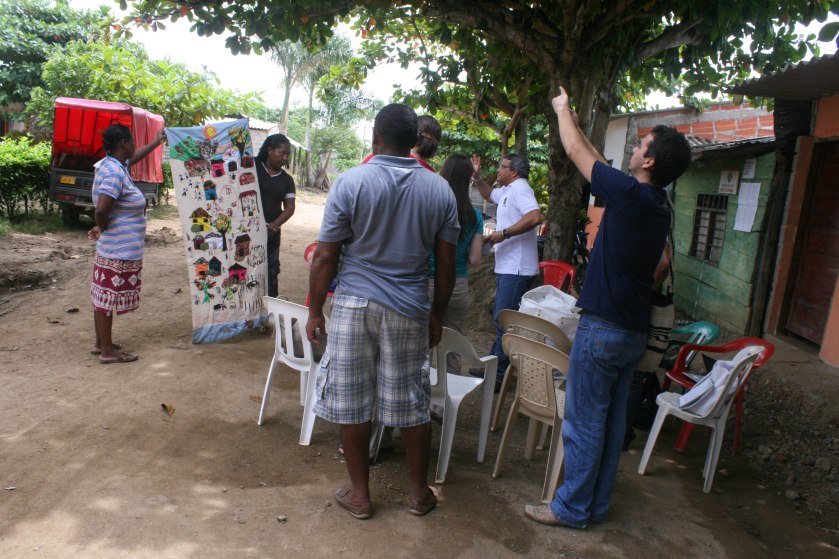Since I'm busy chewing on that, rather than write my own blog post I want to share one related to those issues. I've long been a fan of the blog the Llama Diaries and was lucky enough to finally get to sit down with the author Anna on this trip. She recently wrote a great post about the difficulties of sharing stories about violence in Colombia without reinforcing stereotypes. With her permission, I'm reposting it below in its entirety.
Storytelling, Ethics and Violence
Currently, my job is telling stories, but what I tell and how I tell it is more than a job. It is an ethical responsibility, especially because my the majority of my audience is not made up of Colombians, but people whose only experience of Colombia is based on my stories and general stereotypes. I write from a position of power. What I say is taken as truth about the realities of this place. I am developing a Spanish section, but not everything I write is accessible to those I am writing about. The stories I tell about my experiences are filtered at home through Canadian experiences, knowledge and culture. Representations are easily misinterpreted.
We like to rescue people. We love individual heroes. My facebook newsfeed is constantly filled with petitions and stories of violence and victims worldwide, especially related to sex trafficking and rescue industries. We share these stories because, as human beings, we care and want to make a difference in the lives of others and the stories that we tell have the power to move people into action. But what action? And based on what information? Who is actually telling the story? And how does that story play into globalized realities of colonization, economic structures and power inequalities?
Money and other resources are funnelled into situations and towards people because of the stories we tell. Last month, Newsweek’s cover story was an expose about Somaly Mam, a famous Cambodian woman in the sex trafficking rescue industry. It turns out, how she was portraying herself and the supposed victims of trafficking, was blatantly untrue. Yet, in part because of her stories and the prominent support she received from influential people in the US, billions of dollars have been poured into an industry which does little to actually examine the structural causes of migration, labour, and economic policies; it’s main goal is to make us feel good about ourselves and our power to save. In reality, many of the woman “rescued” in Cambodia end up in foreign funded sweatshops, creating our clothes. (An excellent book on the topic is Laura Agustin’s Sex at the Margins.)
As Chandra Talpade Mohany reminds us in Feminism without Borders, “Writing is itself an activity marked by class and ethnic position. However, testimonials, life stories, and oral histories are a significant mode of remembering and recording experiences and struggles. Written texts are not produced in a vacuum. In fact, texts that document Third World women’s life histories owe that existence as much to the exigencies of the political and commercial marketplace as to the knowledge, skills, motivation, and location of individual writers…After all, the point is not just to record one’s history of struggle or consciousness, but how they are recorded; the way we read, receive, and disseminate such imaginative records is immensely significant.” (78).
What happens when I, as a Canadian, write a graphic description of an experience of personal violence in Colombia, for a Canadian audience, as a blogger for Canadian Mennonite recently did? There is a good chance that the context in which the situation took place will not be familiar or understood by my Canadian audience because they do not live here. Instead, their understandings of violence in Colombia may be be further cemented towards stereotypes. The victim of the incident may become the hero, for being brave enough to live and work for change in such a dangerous place, while the Colombians already working for change remain unseen and unheard.
Even though the experience is true, Colombia is misinterpreted and the structures and stereotypes that have helped contribute to increasing urban violence across Latin America are perpetrated. Policies of structural adjustment, free trade deals, deportation of migrants, military interventions: all of these global realities remain unacknowledged and an opportunity to think critically about our negative role is lost because no context is provided.
When our stories portray Colombia as a land of chaos, filled with terrorists, random violence and poverty, we justify Plan Colombia and other interventionist policies. We rationalize the spending of development dollars, such a the collaboration between mining companies and giants of the development world, on economic policies that end up harming the people we believe we are helping. We ignore the Colombians already working for change and become heroes. It helps to remember, as Magaly Sanchez points out, that “Rather than viewing violence as a personal deviation from societal norms, it is more appropriate to consider it a product of structural inequalities, a social phenomenon in which multiple actors resort to the use of violence under similar social circumstances and in mutually reinforcing ways, not as isolated individuals.”
This does not mean that we cannot share our stories of violence. #yesallwomen is a powerful opening to talk about the global violence against women everywhere. To deny our own stories simply because they happened outside of our local context is to also become a victim. But by choosing to work and live in another context, we also must accept the ethical responsibility of how and where we tell our stories so that violence and stereotypes do not continue to be perpetrated, especially when, because of language and publication location, those we write about are not able to respond. Even the way I tell my accident story or write this blog is implicated and requires revision.


No comments:
Post a Comment